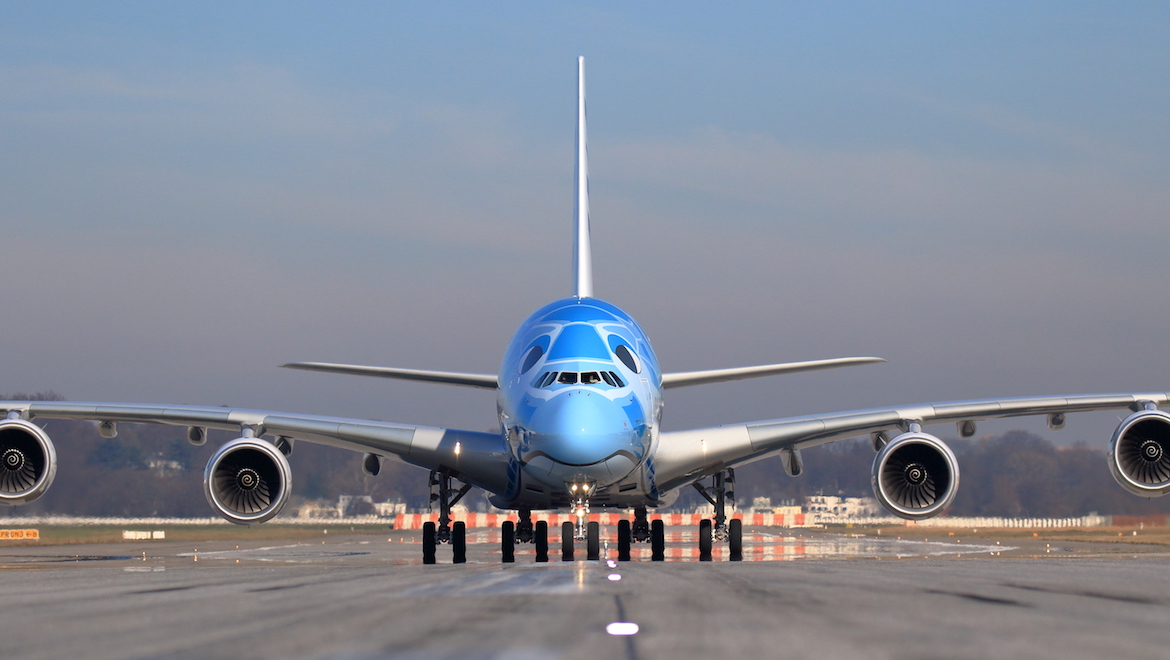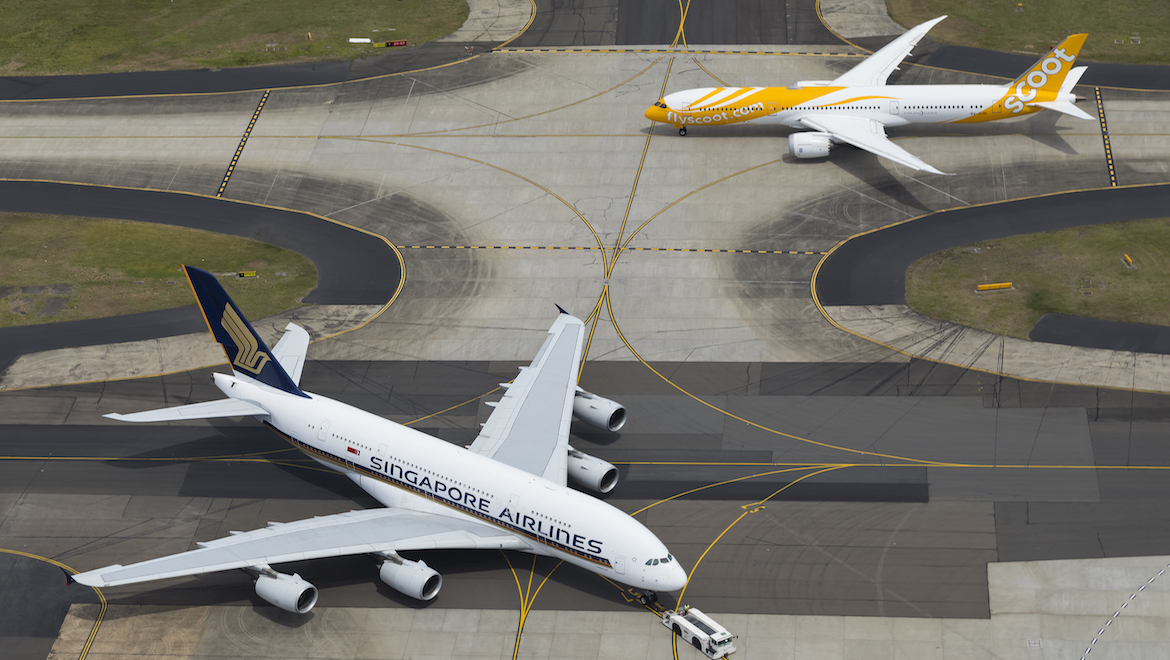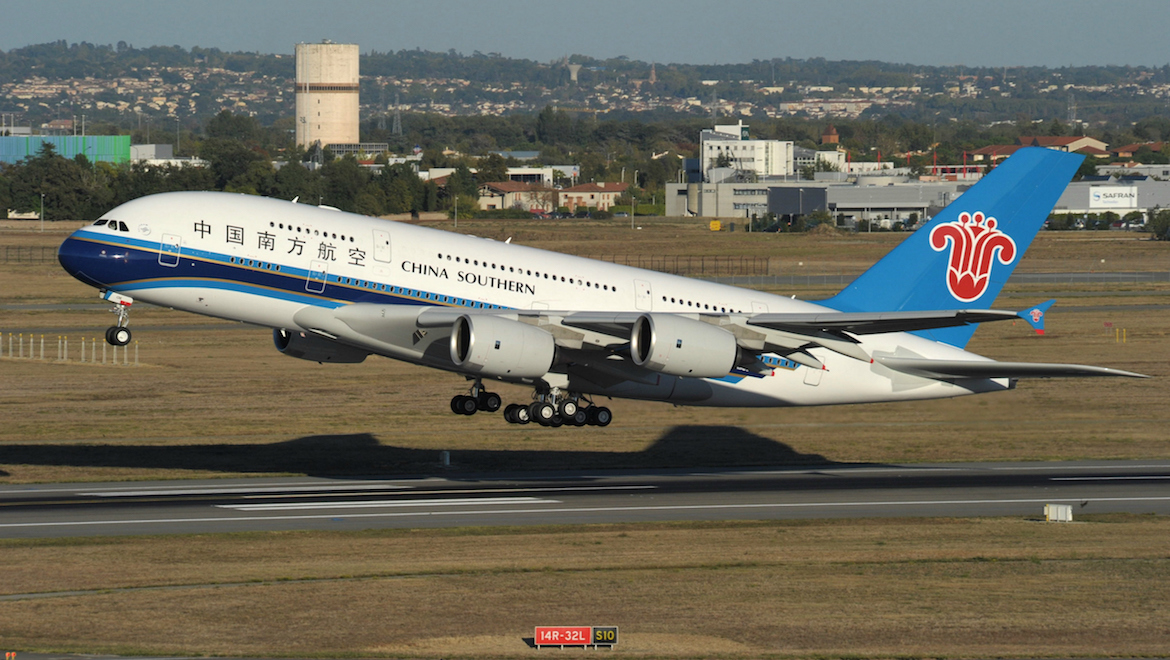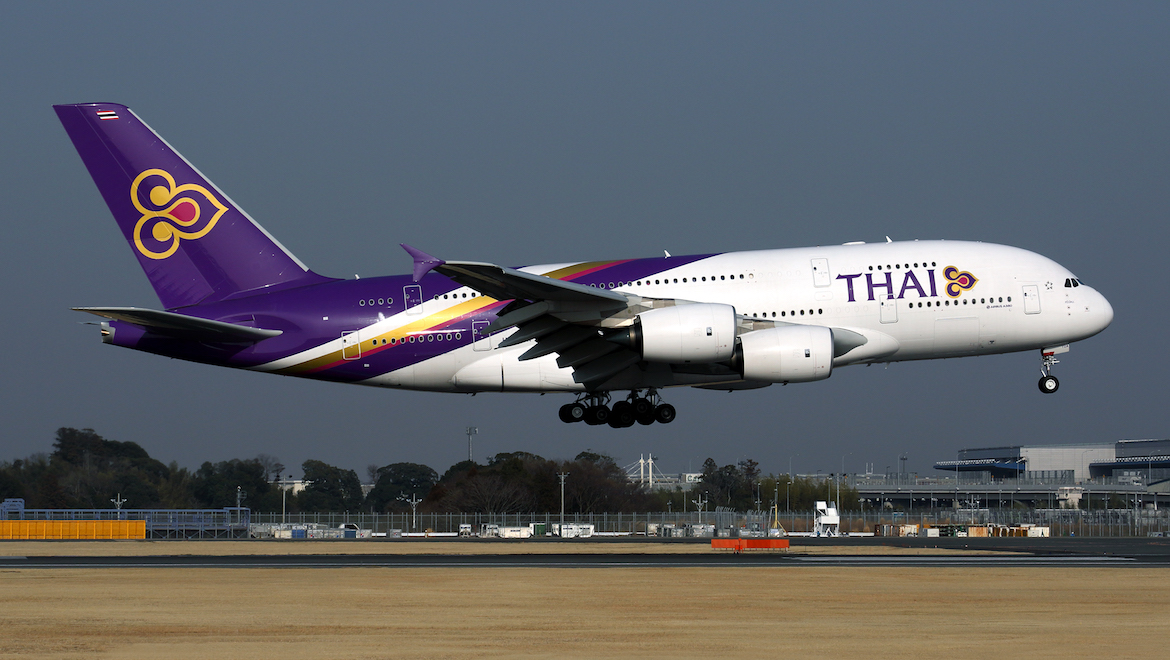This story first appeared in the April 2019 edition of Australian Aviation.

If you had asked anyone standing at the flightlines in Toulouse 14 years ago — when the first Airbus A380 took to the skies — whether the then-35-year-old Boeing 747 would outlive the new superjumbo in production, you’d have had few voices saying yes. But there was little surprise at the news of the A380 programme’s cancellation on February 14: with few new orders in recent years, production was already planned to be reduced to six a year from 2020, a level that was essentially unsustainable.
The world changed under Airbus and under the A380, and the world’s largest passenger plane will cease production in 2021 as Emirates, in a fitting meta-coda, declined to take its final 39 aircraft in favour of smaller, more efficient twinjets: 30 A350-900 and 40 A330-800 aircraft. Emirates is returning to the latter type after having disposed of all its earlier A330s, including to Virgin Australia for its first coast-to-coast widebody operations.
“As a result of this decision we have no substantial A380 backlog and hence no basis to sustain production, despite all our sales efforts with other airlines in recent years. This leads to the end of A380 deliveries in 2021,” said Airbus Chief Executive Officer Tom Enders of his decision to cancel the programme.
“The A380 is not only an outstanding engineering and industrial achievement. Passengers all over the world love to fly on this great aircraft. Hence today’s announcement is painful for us and the A380 communities worldwide. But, keep in mind that A380s will still roam the skies for many years to come and Airbus will of course continue to fully support the A380 operators.”
That Enders was the Airbus CEO to finally put an end to the A380 programme is fitting not just in nominative determinism: it allows a corporate changing of the guard, taking place immediately prior to the installation as CEO of Enders’ successor, Guillaume Faury, who avoids the cancellation being the first mark he makes on the company.
The A380, of course, will not be disappearing overnight. Airlines are still operating the aircraft, and indeed many are doubling down on their A380 strategies. Ahmed bin Saeed Al Maktoum, Chairman and Chief Executive of Emirates Airline and Group, said at the time of cancellation that “Emirates has been a staunch supporter of the A380 since its very inception. While we are disappointed to have to give up our order, and sad that the programme could not be sustained, we accept that this is the reality of the situation.”
From here, it can be reasonably expected that early, heavier A380s in particular will come off lease and be scrapped, but there is also likely to be a cohort of superjumbos that will be refitted and continue to operate for decades to come.
If there is any airline that the A380 changed, it is Emirates, and as Al Maktoum highlighted, “for us, the A380 is a wonderful aircraft loved by our customers and our crew. It is a differentiator for Emirates. We have shown how people can truly fly better on the A380, and Emirates has set the standards for that by introducing customer experiences that are unique to the A380 like our shower spas and onboard lounge. The A380 will remain a pillar of our fleet well into the 2030s.”


Airbus remains positive about the A380’s future
In a statement to Australian Aviation, Airbus highlighted that “230 A380s are flying today with 14 airlines and ANA will become the 15th operator when it takes delivery of its first aircraft this year. The A380 enjoys the support of its customers who see value in operating the aircraft and are making multi-million dollar investments in cabin upgrades to keep it the flagship of their fleets for the years to come.”
Referring specifically to the second-hand market, Airbus highlighted that “British Airways’ parent International Airlines Group’s CEO Willie Walsh has publicly expressed the airline’s willingness to operate more A380s to unlock growth at the congested London Heathrow airport. The A380 was and will remain the ideal aircraft for airlines to operate on high volume routes out of congested airports for the foreseeable future.”
Singapore Airlines, for its part, is refurbishing the remaining 14 of its 19 A380s, after receiving five new aircraft in 2017-18.
“The case for keeping their A380s is strengthened by the fact that existing operators of the aircraft still have over 50 747-400s greater than 18 years of age in their fleets,” Airbus said. “If there was one aircraft the A380 was designed to replace it was the 747-400. There are another 60 747-400s in service around the world with non-A380 customers.”
Airbus suggested that there may be fewer A380s floating around in the second-hand market than previously imagined as a result of its deal with Emirates to reduce order numbers.
“With the reduction of its A380 orderbook by 39 aircraft, Emirates is expected to operate its core fleet of more than 100 aircraft for the rest of their useful economic lives and that core fleet size is also closely matched to the capacity of the Dubai International Airport to handle A380 operations. Consequently, Emirates is expected to put a lower number of used A380s on the secondary market than before,” the airframer said, although other airlines are already releasing early A380s.



Fleet rationalisations are already planned by several airlines
At present, 14 airlines operate the A380: Air France, Asiana Airlines, British Airways, China Southern Airlines, Emirates Airline, Etihad Airways, Hi Fly, Korean Air, Lufthansa, Malaysia Airlines, Qantas, Qatar Airways, Singapore Airlines and Thai Airways. All Nippon Airways will take its three A380s starting this year.
Most of these airlines will continue to operate the A380 in some form or other, although certain carriers are planning to — or would very much like to — reduce their fleet size or remove it from their fleet entirely.
Crucially, the roughly equal split between Engine Alliance powerplants (Air France, early Emirates, Etihad, Korean Air, and Qatar Airways) and Rolls-Royce engines (ANA, Asiana, British Airways, China Southern, later Emirates, Lufthansa, Malaysia Airlines, Qantas, Singapore Airlines and Thai Airways) will naturally create two separate pools of aircraft.
And plans are already underway for the future of the A380.
After multiple changes of corporate direction, Malaysia Airlines recently announced its A380s will operate pilgrimage-tailored services for umrah and hajj passengers, which will include a variety of special passenger experience features including labbaik allah and nasyid boarding music, onboard tazkirah audio, musafir prayers at the start of the journey, the azan call to prayers, and religious content on the inflight entertainment system.
By contrast, Qatar Airways is planning to remove its 10 aircraft from service as they reach their 10th anniversary according to chief executive officer Akbar al Baker, although prognostications from the outspoken “Chief” have not always come to pass.
Air France plans to reduce its fleet but substantially refurbish them from their present rather substandard configurations, while prior to the A380’s sunsetting British Airways’ parent company International Airlines Group’s chief executive officer Willie Walsh highlighted that the British Airways-Iberia-Aer Lingus-Vueling conglomerate would consider adding additional aircraft, though he did
not say whether those might be second-hand.



Peering into the crystal ball, as the early A380 models come off lease they are likely to be returned to lessors, sold off, parted out, or a combination. Over 100 A380s required repair to their wing ribs and rib-feet owing to production quality issues at Airbus’ wingmaking facilities, and these models may well look less desirable to onward operators.
But with certainty about the end of the programme, a niche may well be found for the A380 in the second-hand market. After all, airlines can’t get the Boeing 717 small airliner for love or money these days, and only 156 of those aircraft were ever produced.
The A380 may even go beyond operators like wet-lease specialist Hi-Fly, which has retained the
original Singapore Airlines cabin, but will have to replace the business class seats from disgraced supplier Koito — which falsified certification data — by 2021, when an exemption from regulators expires.
Qantas and Singapore Airlines are already working with Airbus to refurbish their A380s, and Air France will reduce and refurbish its fleet. With aircraft coming in for major overhauls, there is a golden opportunity to save on cabin refurbishment cost while also optimising the A380’s previously generous floorplan.



Cabin refurbishments are a large part of the A380’s future
Changes to the passenger experience of the A380 in service have been relatively few: Qantas’ reconfigurations at the rear of the upper deck, Lufthansa’s replacement of its old business class plus its addition of premium economy, and Singapore Airlines’ recent new configuration, stand out in their rarity.
New cabins will be particularly crucial for Emirates, which has 109 A380s in service at the time of writing, and will take a total of 123 until the line closes in 2021, a substantial proportion both of the 232 currently in operation and the 313 sitting on Airbus’s order book.
The onboard product on Emirates’ latest Airbus A380, despite some minor variations in inflight entertainment systems and the extent to which surfaces are covered in its signature faux burled walnut finish, is relatively similar to that on its very first superjumbo.
Emirates presently states that it operates three different configurations: a 489-seater ultra-long-range version (with a crew rest taking up some space that would otherwise be seats), a 517-passenger long-range version, and a 615-passenger two-class version with only business and economy class seats. The only real upgrades to the Emirates A380 are a reworked bar to the rear of business class in aircraft from mid-2017, and a slightly updated business class cabin overhead bin arrangement and crew rest area in aircraft from late 2016 onwards.
“Emirates will continue to invest in our onboard product and services so our customers can be assured that the Emirates A380 experience will always be top-notch,” chairman and chief executive Ahmed bin Saeed Al Maktoum confirmed when the airline replaced its final orders with A330 and A350 aircraft, and it will be fascinating to see exactly how much of the Emirates A380 experience changes when Emirates announces its refitted cabin.
As just one example, the airline débuted its floor-to-ceiling suite product on Boeing’s 777, and it would be a surprise if it were not ported over to the A380.
Qantas, for its part, is set to replace its Mark III Skybeds with the current Thompson Vantage XL-based Business Suite and add 25 more premium economy seats to increase premium seating on the aircraft by 27 percent. The first of the refitted aircraft is expected in the third quarter of this year, pushed back from Q2, and all twelve planned to be flying by the end of 2020.
“Customers love the A380,” chief executive officer Alan Joyce explained when announcing the A380 refurbishment. “This upgrade is a major investment in putting the next generation of seats on the aircraft as well as more creature comforts to maintain its status as one of the best ways to fly. We’re seeing increased demand for premium economy and business class on the long-haul routes that the A380 operates, including from people using their Qantas points to upgrade. When more travellers experience these new seats, we expect that demand will keep rising.”
Specifically, Joyce said, “working with Airbus we’ve been able to achieve a very efficient layout on the upper deck. Using this space to increase the proportion of premium seating improves the revenue potential and the overall economics of the aircraft.”
Part of the changes will come from deactivating the third set of doors on the upper deck, which will not be required owing to the lower density in premium cabins. This type of change is called Cabin Flex by Airbus, and is also offered on the A321.
A revamped bar area in the “forehead” zone by Qantas designer David Caon is also in the works, and the entire programme will be managed by Airbus’ Services arm, which will be a large part of the way the manufacturer seeks to regain value from the A380.
“Airbus will continue to provide contractual coverage and support to A380 operators,” said the airframer in a statement to Australian Aviation. “The A380 fleet-wide operational reliability (OR) has reached 99 per cent and our 2019 objective is to sustain this 99 per cent OR as a baseline. Airbus will also promote the secondary market of the aircraft together with both the engine suppliers, Engine Alliance and Rolls Royce.”

Densification remains an option during much-needed cabin updates
The A380’s generosity of space is a large part of why passengers love the aircraft. Its economy class seats are the widest in its class, its premium class bars allow travellers to stretch their legs and have a chat on the long haul, and its “forehead” space at the front of the upper deck allows for innovations like onboard showers on Emirates and Etihad, and the latter’s The Residence one-bedroom suite.
When Airbus suggested densifying the A380’s economy class cabin with a 3-5-3 configuration at the Aircraft Interiors Expo in 2015, the mockup went down with prospective passengers like a lead balloon. The generous curve of the A380’s cabin that makes it so wide at shoulder level correspondingly narrows at foot level, making an 11-abreast cabin a prospective nightmare for passengers sitting at the window — let alone in the centre seat of the five-across centre section.
In the years since, Airbus has tried a variety of methods to add seating to the A380 it calls “cabin enablers”: shrinking the staircases, shifting galleys and crew rests, removing the upper deck sidewall stowage, turning premium economy nine-abreast, and in 2017’s A380plus idea, adding a new 4.7m winglet.
None of these proved attractive enough for new customers, but some of them — particularly the upper deck sidewall, 3-5-3 economy class and 3-3-3 premium economy class seating — would not require major structural change, and would add 10 business class passengers, 23 in economy and 11 in premium economy to Airbus’s exemplar numbers.
Many A380s, particularly among early airlines, are one or more generations behind their airlines’ current best-in-show onboard product. Air France, for example, offers business class seating consisting of angled lie-flat sloping sleeper seats. Korean Air’s and Qantas’s business class is in a 2-2-2 configuration, while the current standard on both airlines are 1-2-1 staggered seats from different manufacturers. Malaysia Airlines also offers a 2-2-2 business class, although its current best is an alternating 1-2-1, 1-2-2 staggered flatbed.
But one benefit of adding newer business class seats is densification. Staggered seating, or the latest herringbones when combined with the removal of sidewalls, can add seats in lucrative premium cabins relatively cost-effectively. And as the footprints of premium cabins grow, the overall seat count of the A380 may well drop or remain neutral in the context of the cabin enablers. That would make the A380 fit better in the context of the size difference between the Boeing 777-300ER and 777-9.
Recently, Emirates quoted a 38 per cent capacity hike over previous 777-300ER service to Hamburg when it put a 517-seater three-class A380 on the route, while its 489-seater A380 (lower in seat count owing to crew rests) represents a 22 per cent rise in capacity for Osaka. Without A380s, airlines will need either to quite literally double capacity or to operate two smaller aircraft, creating some interesting fleet planning questions at a time where there are still substantial airport capacity constraints at many high-demand cities.



The A380’s uniqueness will continue to shape the future of travel
An entire generation of airports changed the way they looked, operated and were laid out to attract flights from the oversized A380. The A380 pushed airports to improve their capacity and operations, bringing supersized focus onto problems that otherwise might not have been found.
The ongoing issues at New York’s John F Kennedy, where British Airways cannot presently operate A380s owing to terminal restrictions, and is unlikely to do so in the future due to older taxiways not being A380-capable, are examples at just one of the world’s major airports.
Manoeuvring the world’s largest commercial aircraft has also spurred much thinking and innovation. Would the signature movable winglets on Boeing’s forthcoming 777-8 and -9 look the way they do without the experience of operating the A380? Would dual-use widebody-narrowbody gates be so widely used? Would airlines have been so quick to embrace the wing span of the 777-8 and -9 without adjustments for
the A380’s wingspan already having been made?
Airbus, for its part, is clear that the technological challenges of building the A380 brought substantial technical, engineering and programme management experience to the A350 programme, and it is here that the A380’s legacy is likely to create change as well. It would be a shock if Airbus did not further stretch the A350 platform beyond the -1000 model now that the A350 will be its largest production aircraft.
The European airframer must not lose the ambition that allowed it to build the largest ever commercial passenger aircraft, which has been a halo product itself for many airlines but also allowed passenger experience innovations of a new golden age of flying — would the Etihad Residence have been created on anything else, or would Emirates have installed showers?
“For Emirates, the A380 has been a success,” said Ahmed bin Saeed Al Maktoum when taking delivery of the airline’s 100th superjumbo at the end of 2017. “We’ve been able to utilise it at slot-constrained airports, as well as at regional and ‘secondary’ airports where we have grown passenger demand. Each time we deploy an A380 onto a route, it typically stimulates further traffic and demand as travellers are attracted by our flagship A380 experience.”
And this demand is unlikely to fade, Airbus insisted in its statement to Australian Aviation about the future of the aircraft. “The A380 redefined flying experience in the 21st century and has ferried over 250 million passengers who absolutely love it. Many more millions will be inspired by the majesty of this iconic aircraft over the coming decades.”
VIDEO: Where the Emirates A380 story all began. The official delivery ceremony for Emirates’ first A380 in July 2008 from the Airbus YouTube channel.
This story first appeared in the April 2019 edition of Australian Aviation. To read more stories like this, become a member here.
















Philc
says:Really enjoyed this article (re-read it twice) The analogy to 717 may prove prophetic imo well down the track. I can’t see Etihad being able to afford theirs much longer. Truly hope QATAR not only keep theirs but pick up a few more used later production hulls . Qantas & Hi Fly I hope look at the obvious. MH will eventually ditch A380 I feel for fiscal reasons. Who knows with TG though .The have a habit of keeping orphans Perhaps a “courageous” would reconfigure a hull with cattle class 35 inch pitch and some added goodies to fill them however fuel uplift due to extra weight makes the numbers on some longer routes harder to guess BA could probably absorb 4 to 6 more to ease Congestion on some ports . In hindsight, if only Airbus had got the initial wing design spot on ( freighter considerations on that wing I sense snookered them in a few mods ) From a Pax point of view love them But bean counters will loathe them
Sam
says:Did I read it correctly? “… as Emirates, in a fitting meta-coda, declined to take its final 39 aircraft in favour of smaller, more efficient twinjets: 30 A350-900 and 40 A330-800 aircraft. Emirates is returning to the latter type after having disposed of all its earlier A330s… ” If true, then the a330-800neo is getting some good/big client in addition to Uganda airlines.
Mark
says:The A380 is simply the best passenger experience going around. Nothing compares.
John Wright
says:I would be disappointed if densification results in reduced passenger comfort in A380 Economy. Currently, I much prefer to fly Economy in the A380 because its Economy seats and in particular, its Premium Economy seats are so much more comfortable than those of its newer competitor – the Dreamliner, which I have found particularly uncomfortable for long-haul journeys in comparison to the A380.
Geoff
says:No Sam. 40 A330-900 plus the 30 A350’s.
Lucas
says:@John Wright. I see the seating comfort criticism of the 777/787 apportioned incorrectly to the design by Boeing so many times.
Not that I’m showing any favouritism to airbus or Boeing…. when comparing the Seat comfort between the 777/787 and A350/A330 people make the mistake of attributing this to the plane maker. Yes, Boeing could have made the fuselage slightly wider (at a financial and design/performance cost), however the seating arrangement is strictly the choice of the airliner.
The 787 is incorrectly flown (IMO) by all airlines bar Japan Airlines in economy class at 9 abrest. Only Japan Airlines fly the 787 in its intended economy design seating formation of 8 abreast, which is truly on par with the Airbus A330/A350 experience. If you get a chance to fly the Japan Airlines 8 abreast, do so. A very good product.
Same applies to airlines squeezing 10 abrest into the 777, and reductions seat width in economy class. Unfortunately economics garnished from seating capacity rather than economic harnessed from seating comfort is the order of the day on most legacy airlines to compete against low cost outfits.
Paul Proctor
says:Can’t decide, is this a puff piece disguised as editorial or an opinion piece lamenting the passing of the A380? Contains several unsupportable statements and conjectures. But I agree A380 will find niche use.
AQ
says:I love how you are so optimistic on the future of the A380! With air travel demands growing rapidly, we might be well seeing this plane coming back to production!
Also, a bit of correction: Air France will retain 7, not 5 jets.
Stephen
says:Having flown in suites class (Singapore Airlines) old and new a number of times, i’m not looking forward to going back to standard seating at the front of smaller aircraft. I know one of my next flights will have a 777 sector and it doesn’t have suites, but it would be great if the features of the A380 could be incorporated onto other jets at some stage, especially if the A380 fleets are reduced.